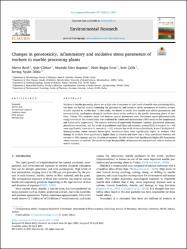Changes in genotoxicity, inflammatory and oxidative stress parameters of workers in marble processing plants

Göster/
Erişim
info:eu-repo/semantics/embargoedAccessTarih
2021Yazar
Becit, MerveÇilekar, Şule
Başaran, Mustafa Mert
Koca, Halit Buğra
Çelik, Sefa
Aydın Dilsiz, Sevtap
Üst veri
Tüm öğe kaydını gösterKünye
Beci̇t, M., Çi̇lekar, Ş., Başaran, M. M., Koca, H. B., Çeli̇k, S., & Di̇lsi̇z, S. A. (2021). Changes in genotoxicity, inflammatory and oxidative stress parameters of workers in marble processing plants. Environmental Research, 197, 111209.Özet
Workers in marble processing plants are at high risk of exposure to high levels of marble dust containing silica, but there are limited studies evaluating the genotoxicity and oxidative stress parameters of workers occupationally exposed to marble dust. In this study, we aimed to clarify how marble dust affects genotoxicity and immunotoxicity mechanisms alongside oxidative stress in the workers in the marble processing plants of Iscehisar, Turkey. The oxidative stress and immune system parameters were determined spectrophotometrically using commercial kits. Genotoxicity was evaluated by Comet and micronucleus (MN) assays in the lymphocytes and buccal cells, respectively. The enzyme activities of superoxide dismutase, catalase, glutathione reductase, glutathione peroxidase, and the levels of glutathione, and Clara cell secretory protein CC16 in workers (n = 48) were significantly lower than in controls (n = 41), whereas the levels of malondialdehyde, 8-oxo-7,8-dihydro-2′-deoxyguanosine, tumor necrosis factor-alpha, interleukin-1beta were significantly higher in workers. DNA damage in workers were significantly higher than in controls and there was a clear correlation between the increase in DNA damage and the duration of exposure. Marble workers had significantly higher MN frequencies when compared to controls. The results indicate the possibility of immunotoxic and genotoxic risks to workers in marble industry.















